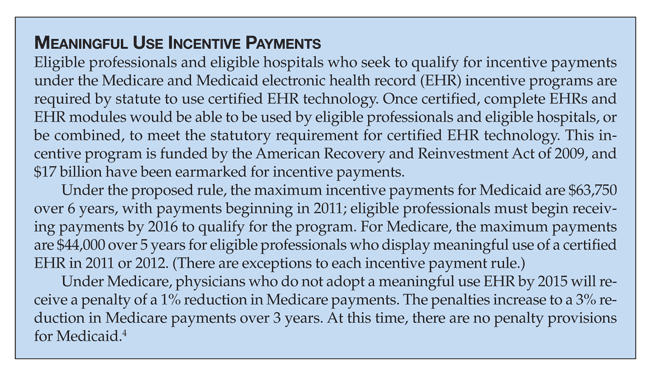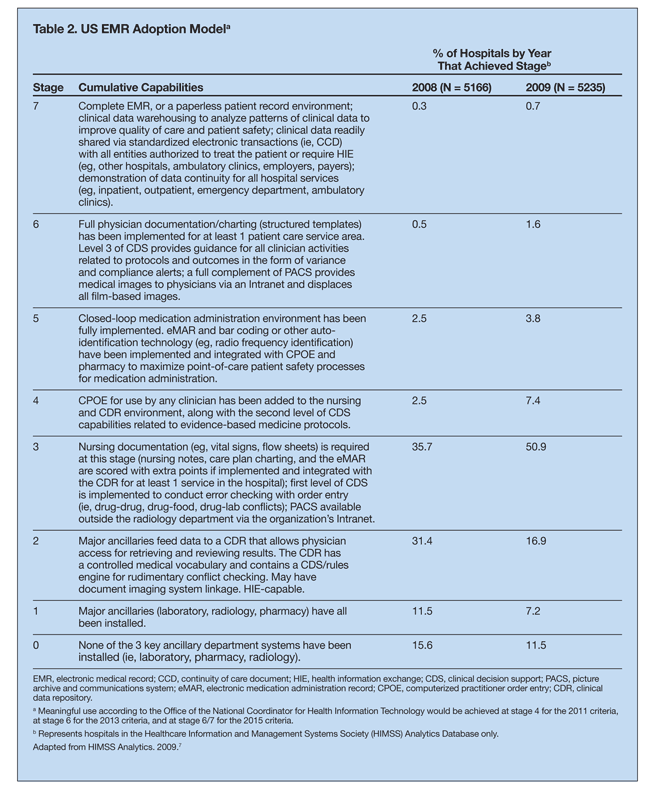EHRs, Meaningful Use, and a Model EMR
On March 2, 2010, the Department of Health and Human Services secretary released a notice of proposed rulemaking for establishing a certification program for electronic health records (EHRs).1
On March 2, 2010, the Department of Health and Human Services secretary released a notice of proposed rulemaking for establishing a certification program for electronic health records (EHRs).1
On March 2, 2010, the Department of Health and Human Services secretary released a notice of proposed rulemaking for establishing a certification program for electronic health records (EHRs).1 Enacted as part of the American Recovery and Reinvestment Act of 2009, the HITECH (Health Information Technology for Economic and Clinical Health) Act mandates the creation of a certification program to assure purchasers and users of EHR technology that the technology has the functionality and security to meet meaningful use criteria.

First, a temporary certification process will be created; then a permanent certification program will be adopted. The idea of this 2-part process is to ensure that eligible professionals and hospitals are able to adopt and implement certified EHR technology in time to qualify for meaningful use incentive payments (Box).
Under the temporary process, the National Coordinator for Health Information Technology, currently David Blumenthal, MD, would authorize organizations to assume many of the responsibilities that will eventually be fulfilled under the permanent certification program. For the permanent certification program, it is expected that much of the testing and certification will be transitioned to organizations in the private sector.

Although the terms “EHR” and “EMR” (electronic medical record) are often used interchangeably, there is a difference between them, and the Office of the National Coordinator for Health Information Technology (ONC) makes the distinction. The EMR is the legal patient record that is created in hospitals and ambulatory environments and is the data source for the EHR. The EHR is the system that gives patients, physicians and other health care providers, employers, and payers or insurers access to a patient’s medical records across facilities. The Centers for Medicare & Medicaid Services (CMS), and subsequently the ONC, believes that certified EHR technology used in a meaningful way is an important piece of the broader health information technology infrastructure needed to reform the health care system and improve health care quality, efficiency, and patient safety. To that end, the CMS has proposed a rule that would phase in criteria for demonstrating meaningful use in 3 stages (Table 1).
For EHRs to be effective, functional EMRs must be in place that allow for an exchange of information between care facilities. According to data from the National Ambulatory Medical Care

Survey, which was conducted by the National Center for Health Statistics, only 41.5% of office-based physicians use any EMR/EHR.2 In addition, according to the Healthcare Information and Management Systems Society Analytics Database, about 61% of US hospitals have some form of EMR (stage 2 or higher, (Table 2) installed to support care delivery.3 However, this percentage needs to be higher to achieve the goal of CMS of meaningful use of EHRs to reinforce the national health information technology infrastructure.
References:
References
1. Blumenthal D. Proposed rule for the establishment of certification programs for health information technology. http://healthit.hhs.gov/portal/server.pt?open=512&mode=2&objID=1799. Published March 2, 2010. Accessed April 16, 2010.
2. Hsiao C-J, Beatty PC, Hing ES, et al, for the Division of Health Care Statistics. Electronic medical record/electronic health record use by office-based physicians: United States, 2008 and preliminary 2009. http://www.cdc.gov/nchs/data/hestat/ emr_ehr/emr_ehr.pdf. Published December 2009. Accessed April 14, 2010.
3. Garets D, Davis M. Electronic medical records vs. electronic health records: yes, there is a difference. HIMSS Analytics. http://www.himssanalytics.org/docs/wp_emr_ehr.pdf. Published January 26, 2006. Accessed April 16, 2010.
4. Centers for Medicare & Medicaid Services. CMS proposes requirements for the electronic health records (EHR) Medicaid incentive payment program. http://www.cms.gov/apps/media/press/factsheet.asp?Counter=3562. Published December 30, 2009. Accessed April 15, 2010.
5. Health IT Policy Council recommendations to National Coordinator for defining meaningful use: final-August 2009. Washington, DC: Department of Health and Human Services, 2009. http://healthit.hhs.gov/portal/server.pt/gateway/PTARGS_0_10741_888532_0_0_18/FINAL%20MU%20RECOMMENDATIONS%20TABLE.pdf. Accessed April 16, 2010.
6. Centers for Medicare and Medicaid Services. CMS proposes definition of meaningful use of certified electronic health records (EHR) technology. http://www2.cms.gov/apps/media/press/factsheet.asp?Counter=3564&intNumPerPage=10&checkDate=&checkKey=&srchType=1&numDays=3500& srchOpt=0&srchData=&keywordType=All&chkNewsType=6&intPage=&showAll=&pYear=&year=&desc=&cboOrder=date. Published December 30, 2009. Accessed April 16, 2010.
7. HIMSS Analytics. U.S. EMR Adoption Model trends. http://www.himssanalytics.org/docs/HA_EMRAM_Overview_ENG.pdf. Published 2009. Accessed April 16, 2010.